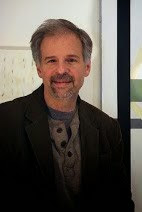 Paul Rinaldi Website
Paul Rinaldi WebsiteI’ve been making encaustic paintings, on and off, for 20 years, though for the past 2 years it has been my principle medium The word encaustic comes from Greek, and means to heat or burn in. Working with successive layers of molten wax, it is necessary to fuse the layers together with a heat source, such as a propane torch, or a heat gun. Beeswax serves as an ideal binder for pigment, and with proper care, encaustic paintings have an archival longevity that exceeds most other painting mediums.
The first encaustic paintings were produced in antiquity by the Greeks, yet among the earliest surviving examples are works dating from the 1rst century CE, produced in the desert oasis of Fayoum, Egypt. While teaching art in the 1990’s at the American University in Cairo, I came across many of the Fayoum “Portraits” that were created to preserve the identity of a deceased individual. These encaustic panels were originally placed over the head and wrapped in the mummy with cloth. While the portraits are somewhat stylized, they preserved with remarkable likeness the particular features of individuals—a consideration vital to the ancient Egyptian death ritual as individuals passed through to the afterlife.
I make my own paints—a mixture of raw pigments and beeswax, together with small proportions of dammar varnish, carnauba, and microcrystalline waxes that impart a degree of flexibility and resilience to the surface. The greatest advantage of making the paint is that I control the pigment load, and thus can adjust the relative opacity or transparency of the medium. Once the wax is heated to a molten state, I brush the paint onto a panel and alternate between building layers, fusing with heat, scraping and carving with various tools, and refining the surface with solvents. Surfaces are often achieved by veiling strong color structures with translucent layers of wax. I like to explore the boundaries between painting and sculpture, and I try to create a dynamic relationship between the visual illusion and the physicality of the object.
While the visual forms in my work grow out of a vocabulary of subtle tension developed by Modernist artists such at Piet Mondrian, Ad Reinhart, Barnett Newman, Agnes Martin, and others, it also speaks to my affinity for antique religious icons, shrines, temples, mosques, and other such objects and places of deep contemplation. I construct my images from memories of light, color, and space gleaned from these sorts of subjects. I very much like the idea that an artwork can function as a focus for human contemplation and reflection—that in some way, it can serve a gateway to both collective and individuated memory. To that end, I look to color to function as an indicator of place—sometimes particular and real, other times imagined.
I want to produce work that collapses time, work that fuses the geometry and structures of the modern and contemporary world with an ancient, almost mystical painting technique. The logic of geometric forms is in some way countered, tempered, or challenged by the sensuality of the wax medium and the organic fusion of color and light. Visually, I want my paintings to speak musically through a crafting of shape, color, line, surface, and space. I’m acutely aware of how these elements repeat and vary through the structure, creating emphasis, and shifting foci, syncopation and rhythm, visual harmony and contrast. At the same time, I’m every bit as interested in the cleansing role of emptiness—the pause, the silence, the waiting, the sense of expectation.

No comments:
Post a Comment